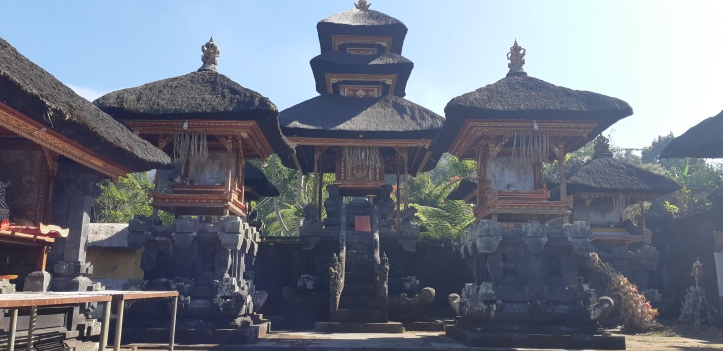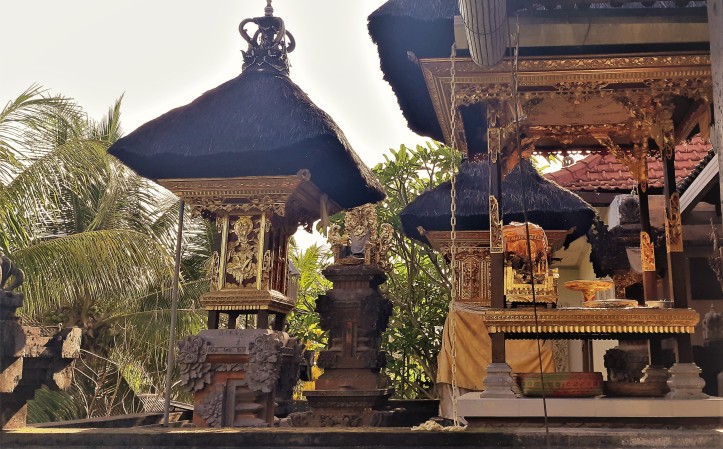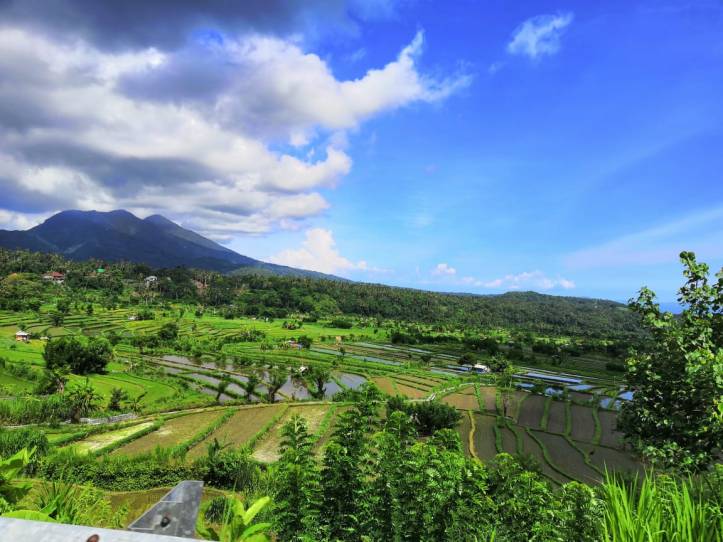I went to Bali as a tourist but came back a pilgrim – deeply touched, spiritually alive and feeling blessed. So overwhelmed I was that in a span of two months I visited Bali twice, the second time mainly to relive the temple experience. All that you may have heard about its the sprawling beaches and exotic resorts is true. But even then, Bali is essentially a temple town. And Balinese are deeply religious (Dharmic is a better word but has not parallel in English), wearing their Hindu-ness proudly. As people of a Dharma that is inclusive and accepting “the other” like none other and propunding piety towards all living creatures as well as the nature around, why shouldn’t they!
Bali’s cultural confidence strikes you the minute you touch-down. After landing and before entering the airport building look right opposite. A huge image of Bhagvan Vishnu on his Garuda stands with a divinely poise, at a distance, towering the “bhu-loka”; as if comforting the visitor that she was going to be safe, satisfied and sound in this sacred land. HE will be there always, watching over! The name “Bali” comes from the sanskrit word bali (small a) which means offerings. Thus, Bali is the land of offerings, the land of gratitude. 
This magnificent piece of art is at the Garuda Wisnu Kecana park in South Bali, not too far from the airport – a must do when in Bali. The other shocker (or surpriser) happens once you are out of the airport heading to wherever your destination is. If you are not asleep already, you can’t miss this exemplary sculpture at the next chauraha – the name displayed in bold says Gatotkaca park. You read that right, the statue of the young but mighty Ghatotkacha, the son of Bhima, taking on Karna in the battlefield of Kurukshetra. My head was literally spinning – there was a huge statue dedicated to Ghatotkacha in Bali – postioned in a way no one could miss. While in my own country India – the cradle of Hindu civilzation – there was none of that scale and grandeur, that I can think of. This was the first such sculpture of the many others adorning various chaurahas of Bali. Sample some in the images below.
As you find your way around Bali, few things will stand out. At the entrance of every home, hotel, restaurant – one finds murtis of Ganeshji watching over the place and the people around. Murtis of Saraswati devi – the goddess of learning and wisdom are also common. All schools and many homes I came across had either murtis or images of the Goddess.
Almost every house, every homestay, every shop has an elaborate temple with usually five “vigrahas” – similar to pillar mounted shrines or covered altars dedicated to – Hyan Sang Vidhi (The ultimate divinity we call Brahman, conceptualised as the unity of Brahma, Vishnu, Shiva), Saraswati, Ishwara (typically Shiva but could be Vishnu per family beliefs), family diety overseeing the temple space and one empty vigrah for Pitrus (ancestors) who bless the homes with their presence on specific days. The vigrahas, unlike temples in India, rarely have murtis but hold carved images of the deity on metal sheets, colored in gold or bright colors. The vigraha for pitrus is empty and is kept closed.

Temples with distinct black roofed altars/vigrahas and split gateways – candi Bentar – are all around. Most are private, such as family temples, community temples and villages temples. Then there are public temples open to all Balinese Hindus and even tourists. Temples such as Besakih, Tanah Lot, Uluwatu etc. which feature in the “Must see” lists of Bali Guide books are some of the public temples.

The people of Bali are very mindful of preserving the sanctity of their tradition. Hence, while they do treat tourists extremely well given the subsistence on tourism, not everyone is allowed in every temple. Even public temples only certain areas are accessible to tourists, that too only after donning a Sarong. Sarongs are provided for free at the entrance of the temples. The garbh grihas (or the inner sanctum) is reserved only for Balinese Hindus. No exception is made for Indian Hindus either. However, if the intention of a non-Balinese Hindu is genuine worship and she is willing to follow the dressing and worshipping ritual of the Balinese, she may be allowed in.
The temple discipline is sacrosanct for the Balinese. One evening, our driver had to attend a family festivity which involved worship in a family temple. All day he was with us in the usual trousers and shirt. But he made it a point to change into the traditional attire before heading home. Even kids are traditionally dressed for temple visits. No exceptions made. Not from one Balinese did I hear any discomfort with this “rule” this. It was understood and accepted by all. I remember one wise Balinese mention – to preserve the culture we must follow the practices, there is no other way. P.S. It’s much easier to enter Balinese Hindu temples in Jakarta as long as one is a Hindu. Of course, Sarong is a must.
A key concept of Balinese Hinduism is Tri-hata-karana, which akin to the vedic concept of Bandhuta propounding connectedness of all things in nature, preaches harmonious living, Tri-hata-karana specifically talks about establishing three types of harmony, amongst Humanity & Divinity, Humans & Humans and Humanity & Enviroment. These three symbolically imply the three vyavahartis uttered during the Shanti mantra – Swarga-lok, bhuva-loka and bhu-loka respectively (from ॐ भूर्भुवः स्वः).
The people of Bali manifest this harmony in their everyday routine. For instance, as a part of the worship ritual, offerings are made to all deities three times a day. Offerings are made in small baskets made by stitching leaves together. These are called Canang sari (chanag sari). Offerings consits of varigated flowers and naivedya of cooked rice. You will see canang saris everywhere in Bali – in front of shops, homes, shrines, on roads, markets – just everywhere. The idea of naivedya enshrines the principle of harmony with nature – the rice is for the ants and other insects on the ground – a beautiful gesture of “Bhuta-daya” . A regular morning sight in Bali is of men and women dressed in traditional attires carrying big baskets of canang sari enroute to the local temples for prayers or praying in their own home temples. The picture below is of my homestay hostess doing her morning ritual.

Balinese care for the nature around not just by ascribing auspiciousness to it but by making efforts to conserve the same. A striking feature in Bali is the lack of air conditioning in most restaurants. Even in homestays, the power of ACs leave much to be desired. When asked, we were told it was by design to keep pollution in check atleast as much as possible!
We got lucky to be there on a day of festivites. Just like desh, there were processions heading to temples accompanied by musical instruments, local music and color array of traditional attires! There were dance performances in the temples, again not different from our own Indian folk tradition.
To the one who seeks, Bali soaks in culture, character and gratitude. It is everywhere – in the air, in the architecture, in the way people live, in the temples and in the nature around. It echoes even in the way they greet – Om Swasti-astu – May all be good, may all be auspicious (for you). The gist is not different from our own Namaste – (I) bow to the divine in you! Both implying a sense of reverence and a prayer of well being for the person.

Life feels so natural, so right and so light here. The only way to describe it would be “sahaj”, a sanskrit non-translatable. This could be my home. Not many places have kindled such a sense of familiarity and comfort in me before.
Yes, yes – I know, most of you are shaking your head and going – Ye sab to thik hai, par Bali mein karein kya? 😀 . So here you go. Read on for Must dos, must sees in Bali.
Some of you might be wondering how did Bali retain its Hindu-ness in an otherwise muslim country. Excellent question . Coming soon.

Do check out other blogs in the #IndonesiaVarta series:
Tryst with Indonesia’s Hindu Heritage – Overview
Indonesia’s Hindu history: Elevator Summary
Post independence Hindu renaissance in Indonesia
Sanskrit influence on Indonesia Bahasa
Bali’s Tri Sandhya and Bharat’s Sandhya Vandana
Travelogues
Prambanan and Borobudur, Yogyakarta
Mt. Bromo: Bliss atop a crater ridge
Om Swasti-astu!

















[…] seep in the real Balinese experience, I suggest, do check out my blog Bali: A touristic pilgrimage before continung with this one if you haven’t already, before. This post is more a laundry […]
LikeLike
[…] Bali: A touristic pilgrimage […]
LikeLike
Loved your article! I felt the same!
LikeLiked by 1 person
[…] Bali: A touristic pilgrimage […]
LikeLiked by 1 person
One feels the peace and serenity ozing in Bali.
LikeLiked by 1 person
I endorse all yu said.It has stirred in me a burning desire to return
LikeLiked by 1 person
[…] Bali: A touristic pilgrimage […]
LikeLike
[…] Bali: A touristic pilgrimage […]
LikeLike
[…] Bali: A touristic pilgrimage […]
LikeLike
[…] Bali: A touristic pilgrimage […]
LikeLike
[…] Bali: A touristic pilgrimage […]
LikeLike
[…] Bali: A touristic pilgrimage […]
LikeLike
[…] Bali: A touristic pilgrimage […]
LikeLike